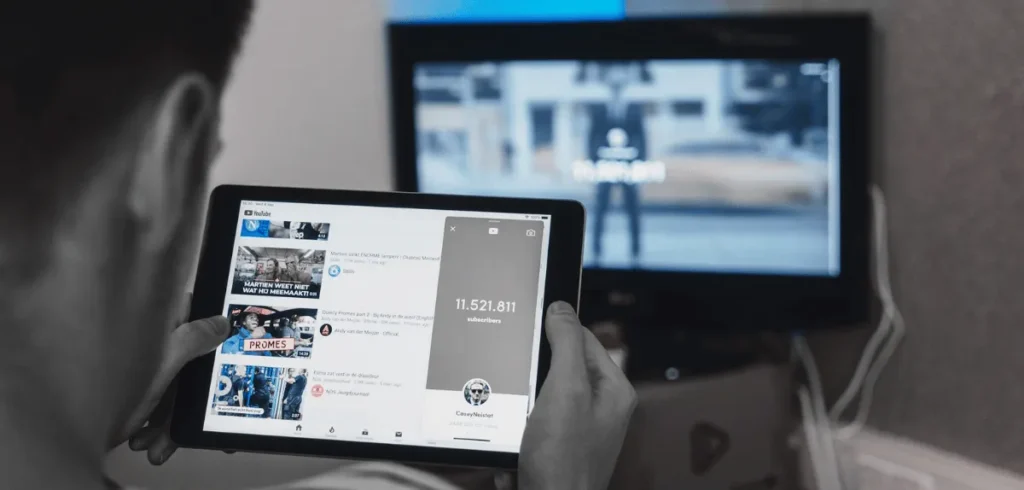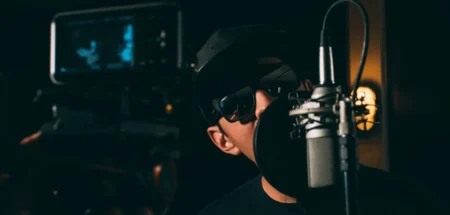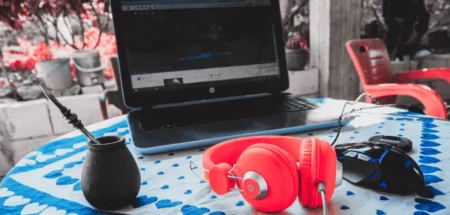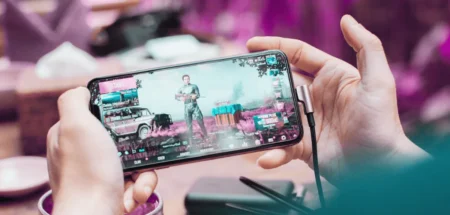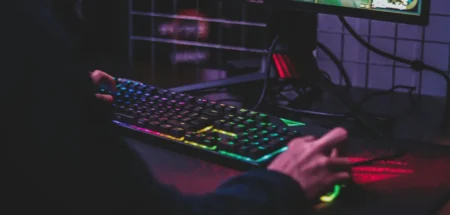You’ve locked in on that YouTube dream. But then information overload hits hard. And you wonder how to be a YouTuber without drowning in doubt.
YouTube influencers like Gary Vee will tell you to “take action, fix later.” But some others are all about “planning everything” first. All of that makes you second-guess your next move.
But don’t fret. This article offers a simple plan to get you going. It mixes action with strategy so you don’t get stuck and can stay on track. Let’s get started.
How to Be a YouTuber: Step by Step
To become a YouTuber, you need to find the sweet spot between planning, taking action, and growing as you go:
1. Know Your Potential
Actually, to be a YouTuber, you can just upload a video and call yourself one. But that’s not why you came to this article, right?
You want to create something meaningful and inspire others, just like your favorite creators, whether it’s MrBeast or Gawr Gura.
To get there, you need to find your unique “it” factor. That’s your raw potential. It’s the mix of personality, skills, and passions that makes you, you, and makes viewers want to watch your content.
Without that, you’ll be lost among 69 million creators competing for attention. Many talented individuals have given up because their efforts felt like shouting into the void.
The truth is, counting on luck isn’t a game plan. So, before you even think about hitting “record,” let’s figure out what makes you impossible to ignore:
- What makes you tick? What really grabs your attention? Games, cooking, origami, vodcast? List five to ten things. Then, rate how much you’d still enjoy talking about them a year from now.
- What are you good at? Cosplaying, voice acting, reacting, explaining complex ideas? No skill is too small.
- What’s your driving force? Building an audience, sharing narratives, earning a living? Your passion will see you through the tough times.
- Mix it up. Don’t just be a gamer. Be the gamer who breaks down game design. Don’t just be a food vlogger. Be the vlogger who focuses on meals from movies.
2. Research Niche Gaps
Love gaming and want to share it with others? That’s awesome. But jumping into a typical “gaming channel” means going up against giants like Markiplier from day one.
That’s not the way to become a YouTuber. Instead of trying to compete with everyone, focus on a specific gaming niche where there aren’t many videos but people are eager to watch.
Look at UpUpDownDown, hosted by WWE star Xavier Woods. The channel features WWE stars competing in video game challenges, from series such as Battle of the Brands to tournaments like First-to-Five Fridays.

It’s all about finding your special spot. By focusing on this, you can become good at it and get more loyal followers who engage more with your content.
Here is what you need to do in this phase:
- Play a detective game in the YouTube search bar. Type words like “FPS tips,” “indie game reviews,” and look for different styles and content people love.
- Read comments on popular videos. Find questions people ask a lot or things they want but can’t find.
- Search using “vs.” and “for” questions. For example, “Fortnite vs. Apex Legends” or “Valorant for beginners” to find specific problems.
- Use tools like TubeBuddy or vidIQ to check how many people search for your keywords.
Related: YouTube Channel Ideas
3. Pinpoint Your Audience
Be honest: you don’t really think your audience is everyone, right? If you do, you’re missing the point. To become a successful YouTuber, you need to focus.
Trying to please everyone weakens your message and makes your videos easy to miss in a busy feed. The YouTube algorithm favors creators who focus on a single topic over general content.
Pinpointing your audience means digging into their world: demographics, psychographics, and behaviors. This turns vague viewers into loyal fans who hit subscribe and share.
Many influencers can inspire you, and Sara Dietschy is one of them. She’s more than just a typical vlogger. People watch her for the behind-the-scenes looks she shares.

Her videos speak directly to anyone interested in filmmaking, tech gear, and branding. That clear focus has helped her build a tight, engaged community.
Get this right, and your content will seem like it’s made just for them. So, how do you do it?
- Create a viewer persona with 2-3 quick examples, highlighting age, interests, and problems, like “20-something gamers fed up with pricey vlogging gear.”
- Explore Reddit and Discord to find out what fans love or complain about in vlogging.
- Look at similar channels using tools like YouTube Analytics or VidIQ to understand their viewers and use that information to improve your own channel.
- Run polls on X or Instagram asking, “What’s your biggest vlogging setup challenge?” then use the answers to shape your first videos.
4. Launch Your YouTube Channel
Maybe you’re thinking, “I want to become a YouTuber… but the first three steps above didn’t even touch YouTube itself. Why’s that?”
We feel you. It’s tempting to just jump in and start making videos. But skipping the setup? That’s like trying to build a house on quicksand.
Your channel is the core of your YouTube presence. It tells new viewers who you are, what you offer, and why they should stay for more.
Before posting your first video, make a bold banner, write a catchy description. This is especially important for someone who wants to know how to become a YouTube content creator.
Here’s what you need to do when launching your YouTube channel
- Pick a standout name. Go for something niche-specific like “WhisperWave ASMR” and double-check it’s available on YouTube and socials.
- Write a great channel description. Keep it tight at 100-150 words. Highlight your unique ASMR style—mention triggers like roleplay or tapping to hook searchers.
- Create eye-catching visuals. Design a calming YouTube banner with soft lights and craft consistent thumbnails using tools like Canva for a polished look.
- Optimize your SEO. Drop relevant keywords into your About section and enable features like custom URLs to boost your visibility before hitting upload.
Related: How to Start Your Gaming Channel
5. Set Your YouTube Goals and Schedule
Thinking about hitting record and just making videos? We’re not here to overwhelm you, but first, get clear on what you want to accomplish.
Knowing your goals shows you the way, keeps you focused, and helps you stay excited, even when progress slows down.
And don’t forget to plan your schedule carefully. That keeps you excited, avoids burnout, and helps you make good content like a pro.
You can check out channels like Sol Life, a travel vlogger. She plans her trips carefully by visiting Seoul during cherry blossom peak and booking tickets early to explore street food markets.
Without this preparation, her videos would look less professional. Planning helps her set up shoots at the best times, turning simple travel footage into interesting stories that catch viewers’ attention.
Here’s how to set your goals the right way when you become a YouTuber:
- Define SMART goals. Set clear targets like “gain 1,000 subscribers in 3 months” related to your niche.
- Make a content calendar. Plan weekly uploads, including time for research or travel.
- Do tasks in batches. Prepare several scripts or shoots at the same time to stay consistent.
- Track and change. Check your progress each month and make changes based on what works.
6. Get Your Production Ready
Would you bother watching Rick Beato break down why “All The Small Things” by Blink-182 is awesome if it sounded terrible on a cheap phone? Probably not.
To be like Rick, you need a good setup to create clear audio demos of riffs. Maybe a professional studio with monitors? Great microphones like Shure SM7B? Or even an isolated sound booth.
Simply put, your equipment shapes your video’s quality. So, if you’re serious about learning how to be a YouTuber, you can’t ignore this.
While that isn’t a standard for new YouTubers, it’s important to have the mindset that good hardware can really help. It matters to your production quality.
Even a vlogger with a simpler setup, like Sara Dietschy, shows how the right production setup can distinguish a beginner from a pro.

Here are some strategies to get your production ready:
- Focus on the most important parts of your content. For audio-heavy things like music analysis, get a good microphone first, even a $50 USB mic. Add lighting if visuals are important.
- Start small and try it out. Use your phone’s camera at first, use free apps like CapCut to edit, then get better equipment as your views increase.
- Make a simple space. Find a quiet spot. Use lamps for light and blankets to soften the sound.
- Grow step by step. Watch your test videos for problems, then buy upgrades one at a time, like better software, to reach your goals without spending too much.
Related: Best Cameras for YouTube
7. Learn How to Script and Storyboard
You can just hit record whenever inspiration strikes. But if you want to become a YouTuber with a huge following, it takes more than just amateur footage.
Sure, MrBeast can get 32 million views by counting from 1 to 100,000. But what makes him really popular are great videos like “$456,000 Squid Game In Real Life!” with 874 million views, or Last To Leave Circle Wins $500,000 with 533 million views.
These videos aren’t made by chance. They’re carefully planned and scripted to keep viewers interested from start to finish. This is what most YouTube influencers do to grow.
Scripting keeps your ideas clear and organized. It helps you stay on track and deliver your message in an engaging way, without rambling.
Storyboarding helps you plan your video visually. It shows how your shots will flow, when to cut, zoom, or add effects—all to make your story clear and engaging.
When it’s time to script and storyboard, follow these steps:
- Outline your script with a quick hook, 3-5 key points, and a strong ending. Keep it under 150 words per minute.
- Use beginner tools like Boords for storyboarding or Celtx’s free plan for scripting templates.
- Sketch 5-10 simple frames on paper or an app, noting shots and text overlays.
- Read your sketches aloud to test clarity and flow.
- Film a short draft, review it, and make adjustments to match your style.
8. Record and Edit Your First Video
This is the moment you’ve been waiting for. Making your first video might seem like a big step in your journey to become a YouTuber.
Don’t worry, you didn’t just start recording now. You’ve done all the preparation. But that doesn’t mean you have to get everything perfect on your first try.
Unclear audio, bad angles, or mumbling during your first important message might happen. It’s not just you. Infinite, with 25 million subscribers, struggled with the same issue at the start.
Right now, Infinite’s recent videos look polished. But every creator starts somewhere. They experiment with different angles, pacing, and styles, learning what works as they go.
And remember, just filming isn’t enough. Editing matters. Even simple cuts, background music, or text overlays can make a difference. It shows you’re serious about being a YouTube content creator.
So, what do you need to do in this phase to become a YouTuber?
- Prepare and record using your plan. Review your script or storyboard, then set up your camera or smartphone, microphone, and lights. Film at your scheduled times.
- Avoid filming excessive extra footage that you won’t use. This helps streamline your video production and keeps your content focused.
- Focus on your niche style. Import your clips into editing software like DaVinci Resolve. Trim your clips to match the pace your audience expects, such as quick cuts for gaming.
- Make your video look professional by keeping your edits simple. Don’t overcomplicate things, or you’ll delay your upload.
9. Upload and Optimize for Reach
Your video is ready. Now comes the important step that separates successful YouTubers from those who hesitate: uploading.
What if Ali Abdaal never uploaded his acoustic cover of “Payphone”? Or what if SSSniperWolf never uploaded “BO2 Fails + Funnies #1”?
So, just go to YouTube Studio, click Create > Upload Videos, and upload your file. Then, add a keyword-rich title, clear description, choose a thumbnail, set audience and privacy options. After that, click Publish.
But you don’t need to go through all these steps every time. Sometimes, you just want to hit publish at the perfect moment. Scheduling your upload is also important.
If your content is ready but your audience isn’t active yet, pick a date and time to post. Then click “Schedule”.
Here’s the tips on how to become a YouTuber in this phase:
- Research and plan your upload times. Check YouTube Analytics to see when your viewers are most active—usually between 2 and 4 pm on weekdays.
- Write clear, SEO-friendly metadata. Start your titles with keywords, write descriptions over 250 words that include your main keyword a few times, and add relevant tags to help viewers find your videos.
- Design eye-catching thumbnails. Use custom images with bold text, clear faces, and contrasting colors to attract more clicks.
- Schedule your videos wisely. Use YouTube Studio’s scheduling tool to post during peak hours, giving the algorithm time to index your video before your audience watches.
Related: How to Add Chapters on YouTube
10. Cross Promote Your Content
Becoming a YouTuber isn’t just about making videos. It’s about growing your audience and building a community that keeps coming back. To do that, you need cross-promotion.
Cross-promotion isn’t just about posting your videos on Instagram, TikTok, or X. It also means using one video to promote another on YouTube, like with end screens.
Plus, it includes collaborating with other creators, so they share your videos, and you share theirs. This works because it puts your content in front of people who already trust the creators they follow.
Take Cinna, for example. She works with top YouTubers across different niches. Her Paris vlog with Valkyrae and Emiru brought in travel fans. Her videos with Sara Saffari attracted new viewers from the fitness niche.

If you’re still unsure if this is worth it, just look at this chart. It clearly shows an upward trend starting in 2024, helping her channel reach 467,000 subscribers and over 410 million views.
So, what are things that will help you become a YouTuber in this phase?
- Find collaborators with similar audience sizes, including different niches. Use tools like TubeBuddy to check their stats and approach them with genuine ideas.
- Create content that benefits everyone, like challenges, guest interviews, or tutorials, and make sure it feels authentic.
- Promote your videos on social media by sharing teasers on Instagram Stories, creating TikTok clips, and posting engaging threads on X.
- Monitor which strategies bring the most subscribers and views, and focus on those to grow your channel.
Related: How to Get More Views on YouTube
11. Manage Audience Engagement
Your job doesn’t end after uploading a video if you want to become a YouTuber with a huge following.
Did you see the likes and comments on the last uploaded video? Don’t let them just sit there. Try to connect with your audience. Turn those interactions into relationships that help your channel grow.
At first, it might feel tough. But keep posting great videos and jumping into relevant comments. Over time, it gets easier.
On YouTube, when a channel reaches 100,000 followers, the engagement rate often jumps above 3.47%. In contrast, larger channels typically only see about 1.5% engagement.
If you want a loyal audience and wider reach, engaging with your viewers, especially when you’re just starting, is a must.
Here are a few tips if you’re aiming to become a YouTuber right now:
- Be present in the first 24 hours. Reply to comments within three hours, aiming for at least 30% personal, genuine responses. Show you’re actively engaged.
- Manage comments strategically. Pin positive remarks to set the tone, plant seed comments to steer discussions, and showcase insightful viewer feedback in future videos.
- Turn engagement into content. Take screenshots of great comments for community posts, answer common questions in new videos, and create content inspired by viewer suggestions.
- Moderate wisely. Use YouTube Studio’s automated filters to catch spam, assign team members to handle different comment types, and keep your community positive.
- Use tools like Phlanx to see your engagement rate or look at others to learn their successful methods.
12. Learn About YouTube Analytics
To be a YouTube creator, your camera, mic, and editing tools are your main assets. But to be a successful YouTuber, you really need a data-driven strategy.
And you can’t do that without understanding YouTube Analytics. It’s a tool that gives you insights into your audience, your content performance, and your channel’s overall growth.
The best part? It’s a free tool built right into your YouTube Studio. With this, you can figure out what’s working, what’s not, and where you should be putting your energy.
By looking at your watch time, audience retention, click-through rates, and where your traffic’s coming from, you can make smart decisions about your content strategy.
For example, if you’re IronMouse, you might notice a pattern: videos posted after 10 p.m. get around 11,000 views, but those uploaded at 8 p.m. jump to 120,000.

This will lead you to analyze things like upload timing, content, and even the day. You can’t jump to a conclusion without first understanding the data from your YouTube analytics.
If you want to become a YouTuber with many viewers, you need to learn this tool:
- Track your traffic sources. Find out where your best subscribers come from—search, suggested videos, or external sites—and create more content that targets those channels.
- Check out your top videos. Spot what they share: topics, formats, lengths, thumbnails. Use those winning formulas to guide your next moves either for recorded or live content on YouTube
- Keep an eye on retention for all your content. Track how long viewers stick around for streaming videos, short clips, and collabs to see what clicks.
- Check out YouTube Studio to see when your audience is most active and which discovery tricks actually bring in your loyal viewers. Use that info to time your uploads perfectly.
13. Set Up Your Revenue Streams
We get it. For many people, becoming a YouTuber starts as a fun hobby. So, you might be surprised to see this step in our guide on how to be a YouTuber.
But think about it: if you want to gain many followers and make your channel last, you need to figure out how to monetize your content.
Doing it just for fun isn’t enough to keep it going. You need better gear, software, or travel to create great videos, right? This last step is what turns your fun hobby into a real job.
You can start with the YouTube Partner Program (YPP). That is the most popular way to earn. But relying only on AdSense can also be slow and risky, especially for beginners.

Thinking about how you’ll set up your income once you become a YouTuber?
- Start with the YouTube Partner Program. It’s the main way to make money on YouTube. Once you hit 1,000 subs and 4,000 watch hours in a year, you can start earning from ads.
- Before you upload your first video, check out platforms like Gank. You can earn from donation or membership for perks like early access or behind-the-scenes content.
- Build multiple streams of income over time. Besides ads, try affiliate links. Share trusted products like tech gadgets, software, or books, and get a cut of sales.
- Think about becoming a YouTube influencer. When your videos hit over 5,000 views each, you can reach out to brands for small sponsorships, even if your channel is niche.
- Make your own products too. Don’t just rely on others. Create something yourself and sell it on your website or Gank.
- Reinvest in yourself. Use 30-50% of your early earnings to level up. Buy better gear, get editing software, or promote your channel to grow even more.
How to Become a YouTuber: A Wrap Up
Start with the basic: choose your niche and plan your content. Then, improve your video production and YouTube SEO skills. These are the must-do steps to become a YouTuber.
Remember, you don’t need to pick between going all-in or obsessing over perfection. Just start with a simple, adaptable plan to get your first video out there and keep growing on YouTube.
And, once your content hooks viewers and gets people talking, you can dive into monetization. Start with in-app options like AdSense for ad revenue and Super Thanks.
Then, you can expand to donations, merch sales, and special commissions via platforms like Gank, to earn more from your content. Interested?
FAQ About How to Be a YouTuber
Is it free to be a YouTuber?
YouTube is a free platform so starting a channel costs nothing. But if you want to be a YouTuber with huge following, you’ll need to invest in better gear or promotion. Many successful YouTube creators began with no budget.
Is it very hard to become a YouTuber?
Getting started is simple, but success demands dedication and a strategy. With over 500 hours of content uploaded each minute, standing out means knowing your niche, understanding your audience, and tracking your results. Many give up early, but consistent effort lead to growth.
Which niche is best for YouTube?
There’s no one-size-fits-all niche. The best one matches your passions with what people want. Tech reviews, gaming, and vlogs are popular, but VTubing and ASMR often face less competition. Use tools like Google Trends to check for real demand.
Is it too late to start a YouTube channel?
No. YouTube keeps growing, with new niches appearing all the time. Even in crowded spaces, fresh ideas and genuine content stand out and find viewers. The secret is offering something unique in your niche, not copying others.
What equipment is needed to be a YouTuber?
Start with what you have: a smartphone, free editing software, and good light. As you grow, a microphone is your first smart buy. Shaky video? People will stick around. Bad sound? They’ll leave. But don’t let that stop you from making great content today.


